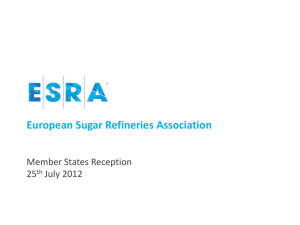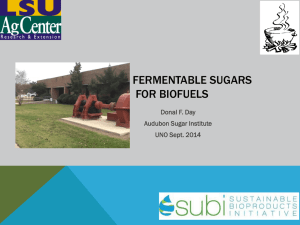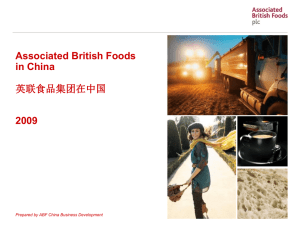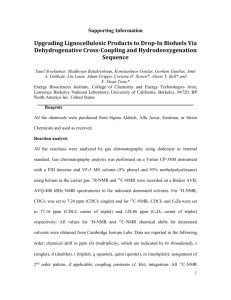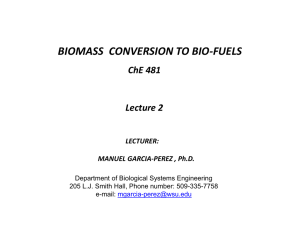presentation by ministry of energy and mining to the sugarcane
advertisement
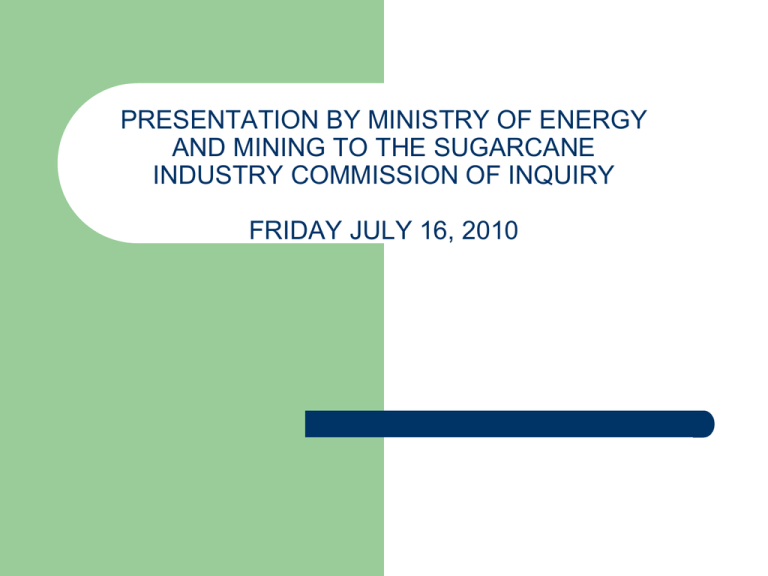
PRESENTATION BY MINISTRY OF ENERGY AND MINING TO THE SUGARCANE INDUSTRY COMMISSION OF INQUIRY FRIDAY JULY 16, 2010 THE NATIONAL ENERGY POLICY OVERVIEW Jamaica’s National Energy Policy (NEP) 2009 – 2030, approved by Cabinet in October 2009 and subsequently laid in the House of Parliament in December 2009. This policy is designed to ensure that by 2030 Jamaica achieves the vision of a: “a modern, efficient, diversified and environmentally sustainable energy sector providing affordable and accessible energy supplies with long-term energy security and supported by informed public behaviour on energy issues and an appropriate policy, regulatory and institutional framework.” The policy aims to facilitate the establishment of a comprehensive program of efficiency improvement and energy diversification to provide high quality, affordable, environmentally friendly energy and to reduce the country’s dependence on high cost imported oil. GOALS THAT RELATE THE SUGARCANE INDUSTRY Goal 3: Jamaica realizes its energy resource potential through the development of renewable energy sources and enhances its international competitiveness, energy security whilst reducing its carbon footprint Goal 4: Jamaica’s energy supply is secure and sufficient to support long-term economic and social development and environmental sustainability IMPORTANCE OF THE SUGARCANE INDUSTRY IN MEETING THESE GOALS The Sugarcane industry and associated diversified products namely, -ethanol and bagasse-electricity cogeneration increasingly offers Jamaica the opportunity to satisfy part of its renewable energy targets in an environmentally responsible and cost-effective manner, whilst reducing dependence on fossil fuels and thereby providing a higher degree of national energy security. As a means of climate change mitigation, sugarcane ethanol and bagasse cogeneration presents one of the few lowcarbon options for the transport and power sectors as it emits lower levels of harmful pollutants. BENEFITS TO BE GAINED BY THE INDUSTRY Sugarcane-ethanol and bagasse electricity cogeneration have been given increasing importance because they form part of the multi-faceted approach that many Small Island Developing countries are taking towards increasing energy security and reducing the use of fossil fuel sources that contribute towards environmental pollution. A diversified sugarcane industry will provide alternative job creation, particularly aimed at rural employment and poverty alleviation, along with factories will be energy self-sufficient. THE BIOFUELS POLICY The National Biofuels Policy currently being drafted seeks “to develop a sustainable biofuels industry that is capable of meeting local demand for biofuels whilst contributing to rural economic development; generating employment opportunities; reducing environment degradation; providing safeguards for food production, and harnessing indigenous energy sources.” The development of a National Biofuels Policy will facilitate the implementation of goals 3 and 4 of the NEP, and will enhance the economic, environmental and energy security priorities for Jamaica. THE BIOFUELS POLICY The policy objectives are as follows: To reduce imports of petroleum products (1.5 % by 2015 and 2 % by 2030), through the promotion of renewable electricity and biofuels. To contribute to cleaner environment and generate carbon emission reductions in line with (CO2 targets of 163,000 by 2015 and 765,000 by 2030). BIOFUELS POLICY To increase and diversify indigenous agro-industry earnings from ethanol, biodiesel and co-products (ex. Bagasse cogeneration, biogas and nutrients from vinasse, glycerol). To ensure that clean renewable electricity and cogeneration of electricity for the grid are inextricably linked to the sugarcane industry. To ensure increased biofuels production will not impact negatively on the availability of lands for food production. GOALS OF THE BFP THAT RELATE TO THE SUGARCANE INDUSTRY Goal 1: To satisfy the E-10 demand for the domestic market by 2015 through the production of ethanol from locally grown sugarcane and other indigenous sources through the modernization of the sugarcane agro-industry and the development other agro-industry. BIOFUELS POLICY Goal 4: To satisfy X% of the public sector electricity consumption by bio-energy associated with the sugar cane and biofuels sector. Goal 5: Contribute to environmental protection through land-use planning and effective waste management. ISSUES RELEVANT TO THE IMPLEMENTATION OF THESE GOALS Divestiture of Sugar Cane Estates and Renewable Energy from Cane Sugar Cane Production Land use policy Current and Future Technologies Divestiture of Sugar Cane Estates and Renewable Energy from Cane Findings – – – No requirements on development of ethanol or cogeneration capacity for the grid Global markets for ethanol, sugar and rum are in flux and investment decisions will be largely determined by prevailing markets Bagasse can provide a significant reliable contribution to the base electrical load Divestiture of Sugar Cane Estates and Renewable Energy from Cane Recommendations: – The public sugar estate divestiture negotiating team needs to consider the national interests of bio-fuels and cogeneration from an indigenous renewable source (bagasse) in reviewing the proposed business plans of this divestiture. – Meet with new estate owners and estate management to assess business plans for ethanol production, power generation for sale to the grid and timelines. Evaluate national indigenous production goals and revise as needed. Key Statistics in Key Years 1994 - 2008 1994 1996 1999 2005 2008 Cane production (tonnes) 2,449,865 2,623,915 2,306,835 1,368,730 1,652,048 Sugar (tonnes) 220,350 237,943 204,200 124,570 140,872 - TC/TS (tonnes) 11.12 11.03 11.30 10.99 11.73 (hectares) 39,158 38,672 37,646 35,739 29,890 (tonnes) 62.56 67.85 61.28 38.30 55.27 Land Reaped - Cane/ha. Notes: significance of years 1994 - year of previous privatization of the industry; 1996 - progress under private ownership; 1999 - year of return to state ownership of SCJ estates; 2005 - formulation of JCS (I), figures affected by impact of Hurricane Ivan in 2004 followed by a drought over the 2004/5 growing season; 2008 - last full year of data. Source: Sugar Industry Authority Summary of JCS (I) Sugar Cane Industry Targets for 2010 Product Raw Sugar Molasses (coproduct) Additional Molasses for rum Sub-total Ethanol Total Production (tonnes/litres) 2010 Target 2009 Actual 200,000 126,000 67,000 40,000 67,000 0.0 Cane Required (tonnes) 2010 Target 2009 Actual 1,900,000 400,000 2,300,000 70,000,000 0.0 1,300,000 1,300,000 1,000,000 3,300,000 1,300,000 Land Required (reaped ha.)* 2010 Target 2009 Actual 25,000 29,000 5,000 0.0 30,000 29,000 13,000 0.0 43,000 29,000 Notes: Land required to be reaped under the JCS for 2010 assumed higher levels of productivity than actually achieved due to underperformance in replanting, maintenance, etc. actions proposed in the strategy. The total cane required to meet these targets is 3,300,000 tonnes and 43,000 ha assuming a yield average of 76.74 tonnes/ha. Source: JCS (I), SIA, SIRI Sugar Cane Production Findings – The Jamaica Country Strategy Sugar Industry targets for raw sugar, molasses and ethanol are achievable. – The total cane required to meet these targets is 3,300,000 tonnes and 43,000 ha assuming a yield average of 76.74 ton/ha. – There are over 50,000 ha of cane lands in Jamaica. The average cane yield in Jamaica and Brazil in 2008 were approximately 55 ton/ha and 87 ton/ha respectively. Sugar Cane Production – The MEM is committed to support the Government of Jamaica Country Strategy (JCS) and the Sugar Industry Research Institute in implementing strategies to increase production while minimizing the environmental impact. – The strategies of the Biofuels Policy will seek to promote energy efficiency, power generation and ethanol production LAND USE POLICY ISSUE: Approximately 200,000 ha of agricultural lands; but many competing interests The most fertile level lands are also the most desired by developers. Preserving agricultural lands for food and bio-energy production will benefit Jamaicans for generations to come. The Ministry of Energy and Mining (MEM) and MOA have a common interest in this area. Recommendation: The MEM to work closely with the Ministry of Agriculture in developing strategies to support the mutual interest in agricultural lands/land use. Current and Future Technologies Climate and experience with sugar cane production give Jamaica unique opportunities for first generation ethanol production. – – Microbial technologies for cellulosic conversion develop direct conversion of bagasse to ethanol will most likely become economically viable. Although still in the early stages of research and development, the climatic conditions of Jamaica for biomass production has potential for third generation hydrocarbons providing a wide range of fuels and co-products. Productivity & sustainability Replanting Cane Fields Increased Mechanization and cane transportation logistics Efficient irrigation drainage and fertilizer application Pricing regime for sugarcane Environmental considerations REPLANTING Cane fields have not been replanted when necessary to maintain yields. – Less than 5% of the fields are replanted annually on public estates. Replanting the majority of land is the first priority to improve yields. The Sugar Industry Research Institute (SIRI) is developing multipurpose cane and high fiber varieties for Jamaica current and anticipated industry needs. The SIRI is a national asset in supporting scientific input to sugar cane potential for renewable energy and the Jamaica sugar industry development and viability. The institute needs to increase its visibility to potential investors. Increased Mechanization and Cane Transportation Logistics The cost structure of cane farming activities consists of harvesting costs representing 37%, cultivation costs 45% of which fertilizer is 22% and irrigation at 8% of total costs As yields increase and availability of hand labor declines, mechanization becomes essential Irrigation Efficiency About 25% of the Sugar Cane lands are irrigated, however, measures to improve yields and consistency of production will likely increase the amount of land under irrigation. Replacement of furrow irrigation systems with efficient center pivot and drip irrigation technologies combined with best management practices for fertilization and irrigation scheduling can maximize yields while reducing per hectare water and fertilizer inputs. A cost benefit analysis will be required on an individual irrigation system basis. Pricing regime for sugarcane The pricing structure for cane has not been reviewed since 1987. The current structure is based on sugar. Revenues for sugar and molasses between field and factory is currently split 62:38 respectively. Consideration needs to be given to an equitable revenue sharing that takes into consideration the multiple co-products and promotes national interest of a stable sugar cane industry and promotion of renewable resources. Environmental Considerations Sugar cane is recognized as having the highest energy balance of any crop used for ethanol production. The ration of energy produced to fossil fuel used as an input to the supply chain is 8.3 compared to corn ethanol at 1.4. The SIRI extension service is a credible partner in education farmers and processors in environmentally sustainable systems. Environmental Considerations Efforts to increase irrigation and fertilizer efficiency, disease and pest resistant varieties and mulching are all best management practices that will conserve water, reduce chemical applications, and reduce soil erosion. Recommends the stoppage of burnt cane harvesting (where appropriate), and education on this issue needs to be supported by regulatory enforcement and penalties for violation. Education and technical support on following ISO 14000 Environmental Management needs to be part of the implementation strategy. CONCLUSION Since the achievement of the objectives for Goals 1 and 4 of the National Biofuels Policy, is inextricably linked to the sugarcane industry and its ultimate viability, the Ministry of Energy and Mining is committed to work in partnership with the industry. Thanks Ministry of Agriculture and Fishes and Divisions/Agencies who have been participating in the development of the Biofuels Policy US Embassy Brazilian Embassy OAS USAID IDB UNDP Other Government Stakeholders



